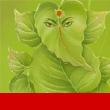Ganesh Chaturthi Pooja
Ganesh Chaturthi Pooja is an important part of celebration of Ganesh Chaturthi, otherwise known as Vinayaka Chaturthi. Creating Ganesh chaturthi pooja during the festival of Lord Ganesha is a ritual. Ganesh Chaturthi is an Indian festival known for its colorful and lively celebration. Although the streets are a wonderful sight to see, many people still observe the festival at home. Here is a procedure on how to perform Ganesha puja according to Hindu scriptures in the comfort of your own home. It is traditionally performed at noontime, but today people perform it when their family is complete.
| Ganesh Chaturthi Cards | ||||
 |
 |
 |
 |
 |
| Ganesh Chaturthi | Lord Ganesha | History | Celebration | Date | Gifts |
| Cards | Greetings | SMS | Wallpaper | Pictures | Scraps |
How to Make Ganesh Chaturthi Pooja
Materials You Need:
- An image of Lord Ganesha made out of clay,
- Flowers that are red,
- Twenty one (21) blades of Druva Grass,
- Twenty one (21) pieces of modak,
- A raw coconut,
- Red sandalwood paste or Red chandan,
- Incense
- agarbathis.
Procedure:
1. Start making your Ganesh chaturthi pooja by cleaning your house and taking a bath.
2. Installing the clay image of Lord Ganesha on a raised platform is the next step in making ganesh pooja.
3. Begin your prayers to Lord Ganesh. You can choose to sing bhajans or recite mantras, whatever you feel will help you show your respects and devotion to Him.
4. Call upon Ganesha into the image. This is called “pran-prathishta”, a mantra in Sanskirt which is found in the Rig Veda and part of Ganesh Suktha. Here is the excerpt:
“ganananh tva ganapatim havamahe kavim kavinam – upamashravastamam |jyeshhtharajam
brahmanan.h brahmanaspata A nah shrivnvannutibhih sida sadanam || (Rig Veda 2.23.1)
ni shhu sida ganapate ganeshhu tvamahurvipratamam kavinam | na rite tvat.h kriyate
kinchanare mahamarkam maghavan.h chitramarcha || (Rig Veda 10.112.9)”
“We invoke You, O Ganapati of the ganas (Lord Shiva attendants), Who are Brahmana- spati of the brahmas (prayers), the wisest among the wise, Who abound in treasure beyond all measure, the most brilliant one. Do listen to our prayers, come with Your blessings and assurances of protection into our home, and be seated. (Rig Veda 2.23.1)
Sit down among the worshippers, O Ganapati, the best sage among the sages. Without You nothing can be done here or far. Accept with honor, O wealthy One, our great and variegated hymns of praise. (Rig Veda 10.112.9)”
5. Afterward, you can perform arati and proceed to light the lamps. If you choose, you can perform sixteen forms of tribute called shhodashopachara. This practice is usually done by the priests.
6. Offer the Druva Grass, the modakas, and the red flowers in that order. The reason why the Druva Grass and the modakas are both twenty-one pieces because the number 21 symbolizes elements of the physical body and the elements: the five (5) organs of action, five (5) organs of perception, five (5) natural elements, five (5) pranas, and one (1) mind.
7. Using the sandalwood paste, apply a tilak.
8. As for the coconut, you can either break it or let it sit with the idol.
9. You can opt then to read the Ganesha Upanishad, to pray, or to recite the one hundred and eight salutations in praise of Lord Ganesha.
Remember that during your observance of the Ganesh chaturthi pooja at home, these strict rituals are usually performed by Vedic priests. What is important is that you perform the pujas with a clean body, a clean mind, and a sincere devotion to Lord Ganesha.